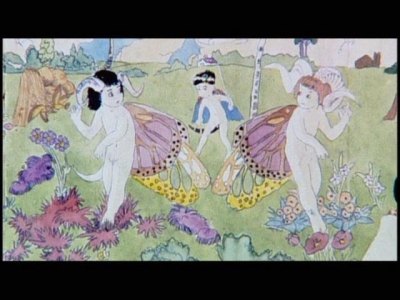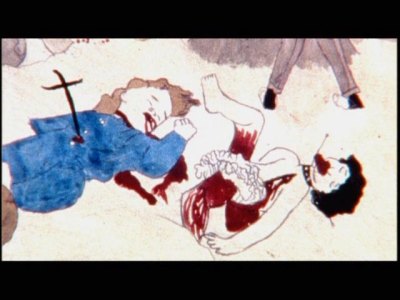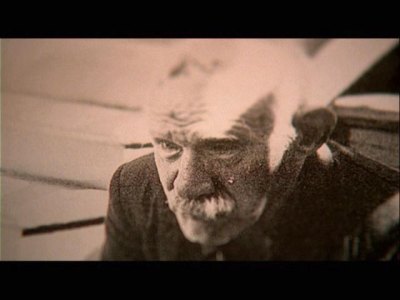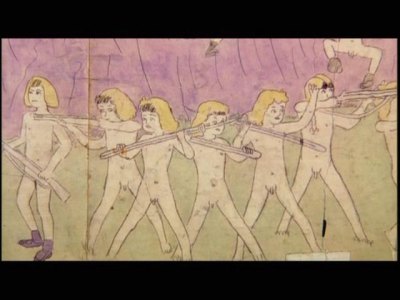| Reviews & Columns |
|
Reviews DVD TV on DVD Blu-ray 4K UHD International DVDs In Theaters Reviews by Studio Video Games Features Collector Series DVDs Easter Egg Database Interviews DVD Talk Radio Feature Articles Columns Anime Talk DVD Savant Horror DVDs The M.O.D. Squad Art House HD Talk Silent DVD
|
DVD Talk Forum |
|
|
| Resources |
|
DVD Price Search Customer Service #'s RCE Info Links |
|
Columns
|
|
|
In the Realms of the Unreal - The Mystery of Henry Darger
"No man is an island, entire of itself; every man is a piece of the continent." - John Donne
It seems that Donne was wrong, at least when it comes to Henry Darger. He was a loner. A man who lived alone in a one room apartment in Chicago where he held a series of menial jobs. He didn't interact with many people, and he didn't have any friends. It wasn't until he was sent to the hospital shortly before his death that his landlord made an amazing discovery: Henry had spent the past 60 years writing the world's longest novel. Weighing in at a mind boggling 15,000 pages, Darger also illustrated it with large canvases up to ten feet in length and composed song to accompany sections of the epic work. Darger didn't so much think up this book as chronicle the fantasy world that he lived in. He wasn't part of the continent, he was an island.
Never marring or having any relatives, Darger is largely an enigma. Filmmaker Jessica Yu has made an interesting and engaging biopic about this unique individual; In the Realms of the Unreal: The Mystery of Henry Darger which is now available on DVD.

Most of what is know about Henry Darger comes from the autobiography he wrote late in his life. In it he relates how he was born in 1892 in Chicago and reveals that his mother died when he was two. A seemingly intelligent child, he could read the newspaper before he ever went to school. When he did go to school though, things didn't work out very well. He often disrupted the class by making noises and this alienated him from the teachers and the other children. The school had him examined by a doctor and then taken away and put in an asylum for feeble-minded children that was in middle Illinois. He was about ten years old.
At this institution, they made Henry work on a farm from 7 in the morning till 5 at night. The conditions were rough, with the supervisors had permission to beat the children in their care. Henry tried to run away several times, and finally succeeded in escaping when he was 17. He walked the 180 miles back to Chicago. His father had died while he was in the asylum, and he didn't know anyone. So he got a job in a Catholic Hospital as a janitor and took a room in a nearby house.
In 1909, he started to write a novel; The Story of the Vivian Girls, in what is Known as the Realms of the Unreal, of the Glandeco-Angelinian War Storm, Caused by the Child Slave Rebellion. A fantasy epic that would take him the over 60 years to finish and eventually reach 15,000 pages in length, mostly in single spaced typed pages. He also painted scenes from his book. Using cheap butcher paper, Henry would create water color tapestries that were up to ten feet in length and painted on both sides. He would write lyrics to accompany instrumental songs and incorporate these into his magnum opus. Living alone and apart from society, he created his own world. A bizarre and sometimes eerie world filled with amazing battles, last minute rescues and heroic deeds. A world that was much more interesting to him than the real one.
The novel is about an atheist country, Glandina, whose economy is based on child slavery. There is an uprising of the slaves lead by seven princesses, the Vivian sisters. Joining the young girls is the Christian nation of Angelinia which declares war on Glandina over their barbaric practices. The Vivian girls, the heroines of the novel, experience countless tragedies and horrors, including torture, of the course of the epic.

Darger didn't only write his novel though, he also wrote an autobiography and filled volumes with other writings. He spent ten years chronicling the weather, and noting every instance where the newspaper's weather forecast was wrong. He kept detailed accounts of Glandeco-Angelinian War too, filling book after book with the details of the battles including the cost of munitions and lists of the thousands of officers killed and wounded in the various conflicts. Darger also was found of cutting out pictures of girls from newspapers and magazines and pasting them onto the pages of old phone books.
All of this, his writings, his paintings, and his collections of pictures and twine (over 1000 balls) were all discovered by his landlord when he was hospitalized after he could no longer take care of himself. Henry Darger died at the age of 81 in 1973.
The creator of this film faced an interesting problem: How do you film a biography about a man who has no relatives, no friends, and very few acquaintances. There were no newspaper articles about him or other sources of information. Even photographic evidence is very scant; there are only three picture of Henry in existence. Much of Darger's life is a mystery: Why did he write the book? What was he hoping to accomplish? Was he mad?
Jessica Yu finds an interesting solution to this problem. She embraces the mystery of his life. She doesn't try to come to pat conclusions. There are no psychologists interpreting his writings and paintings. Instead she weaves three different narratives together to form some sort of picture of Henry Darger and lets the viewer reach their own conclusions.

The first narrative is from Darger's autobiography. With an actor reading passages over scenes from his book and photographs of the places he's talking about, you get to see Darger the way he saw himself, though a rather sanitized and unemotional version. Some of the passages, though they are in first person, sound like there were written by an objective observer rather than the subject himself.
A few neighbors and acquaintances of Darger's are also interviewed. It is amazing how contradictory some of their thoughts on Henry are. They can't even agree on the pronunciation of his last name; the four people interviewed pronounce it three different ways. There are many aspects that they all agree on though: Henry didn't want to interact with people, he would spend hours alone in his room talking to himself, most often in strange voices or with odd accents, and he had no friends.
The last piece that is woven through this film are sections of the book itself. It is obvious that much of the plot of the book was taken from Henry's life at the asylum farm: The child slave labor, the cruel punishments, and the strict consequences if someone tries to escape. All of these events in the novel parallel his turbulent childhood. The painting that he drew also provide an interesting look into his mind. Some of the pictures are rather unsettling, like the tapestry of disemboweled children, and others are a little strange. He often illustrates the young female heroes of his book nude, but he gives them penises. This seems to indicate that he never knew the difference between the sexes, something that probably wouldn't be taught in an asylum for children at the turn of the last century.

These three views, how he perceived himself, how others saw him and the fantasy world that he spent most of his time in all come together to give an interesting and engaging portrait of Henry Darger, but still and very incomplete one.
Jessica Yu has done a splendid job of creating a film biography of this cipher though. The way she has constructed the film, with the three interwoven narratives illustrated with pictures of Darger's room as he left it and many photos of his paintings, really forms an image of this very private man. Even the contradictions in the various testimonies show how little people really knew him.
I really only have a couple of complaints about this film. The first is that many of Darger's paintings were animated for this movie. They would move the various characters around the backgrounds, letting their arms and legs swing, much in the same way that Terry Gilliam would create animation for Monty Python. I though this altering of his original work cheapened it. I was never sure what the original image was supposed to be. I can understand that the director wanted movement in her film, but I don't think it was necessary. It came across as cheap theatrics and was distracting from the main theme of the film.
The other criticism, a more minor one, is that I never really got a feeling for the scale of Darger's tapestries. It was stated that some of them were ten feet long, but the film mainly showed close ups and pans across sections of the paintings. I would have appreciated seeing a couple in full view, preferable with something in the frame so I could get a sense of dimension, so that his sense of composition and perspective could be determined. Neither of these are major strikes against the film, just decisions that I don't agree with.
The DVD:
Audio:
The two channel audio fit the subject matter well. The sound was clean and solid, and there were no audio defects. No subtitles are available.
Video:
The widescreen image was not anamorphically enhanced, but otherwise looked good. The lines were sharp, the colors solid, and the level of detail was fine. Aside from one brief instance of aliasing, I didn't notice any digital defects. A fine looking disc.
Extras:
This disc has a few nice extras included with it. The main extra is an interview with writer/director Jessica Yu. In this half hour talk she discusses how she discovered the work of Henry Darger and the five years that she spent working on the film. It was often hard to hear the questions that the interviewer was asking, but aside from that the interview was very interesting.
There is also a series of story boards used for the film, a photo gallery of Darger's paintings, and a filmography of the director's work.
Final Thoughts:
After watching this film I'm sure that Henry Darger had mental problems. Even so, he was still a productive member of society, working until he was 73 years old when he was forced to retire. Never owning a radio or TV set, Henry poured his efforts into something that no one else has ever done: He wrote the longest book in the world. His intricately detail work of fiction includes songs, paintings and supplemental journals detailing the costs and casualties of a giant war. It just boggles the mind to think about someone working for over sixty years on such a project, and never showing or mentioning it to anyone.
Jessica Yu's movie about this man is at once both entertaining and a little aggravating since so much is still not known. Subtitled The Mystery of Henry Darger, it is an all too apt description. The man was a mystery, and one that will never be answered. She does do an excellent job at casting as much light as possible on his character without jumping to conclusions or assuming too much. After researching the man for nearly five years, the temptation to present one view of him must have been great. I'm glad that she was able to stay very objective, it made the movie much stronger. Highly Recommended.
|
| Popular Reviews |
| Sponsored Links |
|
|
| Sponsored Links |
|
|
| Release List | Reviews | Shop | Newsletter | Forum | DVD Giveaways | Blu-Ray | Advertise |
|
Copyright 2024 DVDTalk.com All Rights Reserved. Legal Info, Privacy Policy, Terms of Use,
Manage Preferences,
Your Privacy Choices | |||||||














